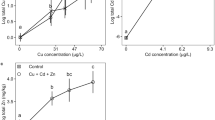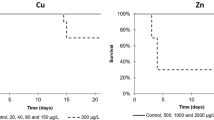Abstract
A series of toxicity tests were conducted to investigate the role of chronological age on zinc tolerance in juvenile brown trout (Salmo trutta). Four different incubation temperatures were used to control the maturation of the juveniles before zinc exposures. These 96-h exposures used flow-through conditions and four chronological ages of fish with weights ranging from 0.148 to 1.432 g. Time-to-death (TTD) data were collected throughout the exposure along with the final mortality. The results indicate that chronological age does not play a predictable role in zinc tolerance for juvenile brown trout. However, a relationship between zinc tolerance and fish size was observed in all chronological age populations, which prompted us to conduct additional exploratory data analysis to quantify how much of an effect size had during this stage of development. The smallest fish (0.148–0.423 g) were shown to be less sensitive than the largest fish (0.639–1.432 g) with LC50 values of 868 and 354 µg Zn/L, respectively. The Kaplan–Meier product estimation method was used to determine survival functions from the TTD data and supports the LC50 results with a greater median TTD for smaller fish than larger juvenile fish. These results indicate that fish size or a related characteristic may be a significant determinant of susceptibility and should be considered in acute zinc toxicity tests with specific attention paid to the expected exposure scenario in the field.




Similar content being viewed by others
References
Alam MK, Maughan OE (1992) The effect of malathion, diazinon, and various concentrations of zinc, copper, nickel, lead, iron, and mercury on fish. Biol Trace Elem Res 34(3):225–236
American Public Health Association (1985) Standard methods for the examination of water and wastewater (16th ed). APHA, American Water Works Association, and Water Pollution Control Federation, Washington, DC
American Society for Testing and Materials (2005) Standard E-1241. Guide for conducting early life stage toxicity tests with fishes, ASTM International, West Conshohocken, PA
American Society for Testing and Materials (2007) Standard E729-96. Standard guide for conducting early life stage toxicity tests with fishes, ASTM International, West Conshohocken, PA
Barnett TP, Pierce DW, Hidalgo HG, Bonfils C, Santer BD, Das T et al (2008) Human-induced changes in the hydrology of the western United States. Science 319(5866):1080–1083
Beniston M (2005) Mountain climates and climatic change: an overview of processes focusing on the European Alps. Pure appl Geophys 162(8–9):1587–1606
Brinkman SF, Davies PH, Hansen DL, Viera N (2006) Arkansas River Research Study: Final report, period April 1994 to December 30, 2005. Fort Collins, CO
Brown ME (1951) The growth of brown trout (Salmo trutta linn.): the effect of food and temperature on the survival and growth of fry. J Exp Biol 28:473–491
Brown TB Barry RG, Doesken NJ (1992) An exploratory study of temperature trends for Colorado paired mountain-high plains stations. In: American Meteorological Society Sixth Conference on Mountain Meteorology. pp. 181–184
Buhl KJ, Hamilton SJ (1991) Relative sensitivity of early life stages of Arctic grayling, Coho salmon, and rainbow trout to nine inorganics. Ecotoxicol Environ Saf 22(2):184–197
Chapman GA (1978) Toxicities of cadmium, copper, and zinc to four juvenile stages of Chinook salmon and steelhead. Trans Am Fish Soc 107:841–847
Clow DW (2010) Changes in the timing of snowmelt and streamflow in Colorado: a response to recent warming. J Climate 23(9):2293–2306
Crespo S, Balasch J (1980) Mortality, accumulation, and distribution of zinc in the gill system of the dogfish following zinc treatment. Bull Environ Contam Toxicol 24(6):940–944
Davies PH, Woodling JD (1980) Importance of laboratory-derived metal toxicity results in predicting in-stream response of resident salmonids. In: Eaton JG, Parrish PR, Hendricks AC (eds) Aquatic Toxicology. American Society for Testing and Materials, pp 281–299
Diedrich DJ (2007) The effects of chronological age and size in juvenile brown trout exposed to zinc. Master’s thesis. Western Washington University, Bellingham, WA
Elliott JM, Hurley MA (1998) Predicting fluctuations in the size of newly emerged sea-trout fry in a Lake District stream. J Fish Biol 53(5):1120–1133
Fredenburgh D (1969) The potential weight loss of rainbow trout as a result of starvation. Prog Fish Cult 31(3):172–173
Fu C, Wilson JM, Rombough PJ, Brauner CJ (2010) Ions first: Na+ uptake shifts from the skin to the gills before O2 uptake in developing rainbow trout, Onchorynchus mykiss. Proc R Soc Lond B Biol Sci 277:1553–1560
Hedtke J, Robinson-Wilson E, Weber L (1982) Influence of body size and developmental stage of coho salmon (Oncorhynchus kisutch) on lethality of several toxicants. Fundam Appl Toxicol 2(2):67–72
Hoang TC, Tomasso JR, Klaine SJ (2004) Influence of water quality and age on nickel toxicity to fathead minnows (Pimephales promelas). Environ Toxicol Chem 23(1):86–92
Hoff DJ, Wall VD, Brinkman SF (2004) Studies on the toxicity of upper Arkansas River water of Brown trout fry. Unpublished research report. USEPA, Washington, pp 1–2
Holcombe GW, Benoit DA, Leonard EN (1979) Long-term effects of zinc exposures on brook trout (Salvelinus fontinalis). Trans Am Fish Soc 108(1):76–87
Huxley JS (1950) Relative growth and form transformation. Proc R Soc Lond B Biol Sci 137:465–470
Jager HI, Van Winkle W, Holcomb DB (1999) Would hydrologic climate changes in Sierra Nevada streams influence trout persistence? Trans Am Fish Soc 128:222–240
Jensen AJ (1990) Growth of young migratory brown trout Salmo trutta correlated with water temperature in Norwegian rivers. J Anim Ecol 59(2):603–614
Lawrence WM (1941) The effect of temperature on the weight of fasting rainbow trout fingerlings. Trans Am Fish Soc 70(1):290–296
Niyogi S, Wood CM (2004) Biotic ligand model, a flexible tool for developing site-specific water quality guidelines for metals. Environ Sci Technol 38(23):6177–6192
R Statistical Software. R Development Core Team (2008). R: A language and environment for statistical computing. R Foundation for Statistical Computing, Vienna, Austria. ISBN 3-900051-07-0, URL http://www.R-project.org. Accessed 15 Mar 2008
Ritz C and Streibig J (2006) The drc package: Analysis of dose-response curves. http://auckland.ac.nz/software/CRAN/doc/packages/drc. Accessed 15 Mar 2008
Rombough P (2007) The functional ontogeny of the teleost gill: which comes first, gas or ion exchange? Comp Biochem Physiol A 148(4):732–742
Stubblefield WA, Steadman BL, La Point TW, Bergman HL (1999) Acclimation-induced changes in the toxicity of zinc and cadmium to rainbow trout. Environ Toxicol Chem 18(12):2875
Toll J, Garber K, DeForest D, Brattin W (2014) Assessing population-level effects of zinc exposure to brown trout (Salmo trutta) in the Arkansas River at Leadville Colorado. Integr Environ Risk Assess 9(1):50–62
Wells PR, Pinder AW (1996) The respiratory development of Atlantic salmon: I. Morphometry of gills, yolk sac and body surface. J Exp Biol 199:2725–2736
Wheeler MW, Park RM, Bailer AJ (2006) Comparing median lethal concentration values using confidence interval overlap or ratio tests. Environ Toxicol Chem 25(5):1441–1444
Williams ND, Holdway DA (2000) The effects of pulse-exposed cadmium and zinc on embryo hatchability, larval development, and survival of Australian crimson spotted rainbow fish (Melanotaenia fluviatilis). Environ Toxicol 15(3):165–173
Acknowledgments
This research was funded by the USEPA, Region VIII, with support from Western Washington University, Colorado Division of Wildlife, and Colorado School of Mines.
Author information
Authors and Affiliations
Corresponding author
Electronic supplementary material
Below is the link to the electronic supplementary material.
Rights and permissions
About this article
Cite this article
Diedrich, D.J., Sofield, R.M., Ranville, J.F. et al. The Effects of Chronological Age and Size on Toxicity of Zinc to Juvenile Brown Trout. Arch Environ Contam Toxicol 69, 123–131 (2015). https://doi.org/10.1007/s00244-015-0151-x
Received:
Accepted:
Published:
Issue Date:
DOI: https://doi.org/10.1007/s00244-015-0151-x




